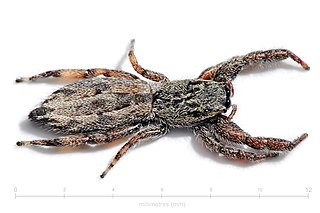
Abracadabrella is a genus of spiders in the family Salticidae whose species appear to mimic flies.

Afraflacilla is a genus of the spider family Salticidae. Most species are distributed in Eastern to Northern Africa and Australia, with two species found in Europe. This genus was for a time included in the genus Pseudicius, and the boundaries between both genera are disputed. In 2016 Jerzy Prószyński erected the genus Psenuc for some borderline species. The name Afraflacilla is combined from Africa, where most earlier described species were found, and FlacillaSimon, 1901, an obsolete salticid genus now called FlacillulaStrand, 1932. This genus name is in turn derived from Aelia Flaccilla, wife of Roman Emperor Theodosius I. Afraflacilla, Pseudicius, Festucula and Marchena are close relatives and form a monophyletic group.
Bulolia is a genus of Papuan jumping spiders that was first described by Marek Michał Żabka in 1996. As of June 2019 it contains only two species, found only in Papua New Guinea: B. excentrica and B. ocellata.
Chalcolecta is a spider genus of the jumping spider family, Salticidae.

Hinewaia is a genus of the jumping spiders found in New Zealand. Its single described species is Hinewaia embolica.

Holoplatys is a genus of the spider family Salticidae.
Huntiglennia is a genus of jumping spiders found in New South Wales, in the brigalow belt. Its single described species is Huntiglennia williamsi.

Marchena is a genus of jumping spiders only found in the United States. Its only described species, M. minuta, dwells on the barks of conifers along the west coast, especially California, Washington and Nevada.

Margaromma is a spider genus of the jumping spider family, Salticidae. The eight described species occur mostly in Australia and New Zealand, with several other species on Pacific islands. One species is found in Cameroon.
Megaloastia is a genus of spiders from Western Australia, which is placed in the jumping spider family, Salticidae. The genus has only one species, Megaloastia mainae.

Salticus is a genus of the family Salticidae. Salticus is the type genus for the family Salticidae.

Trite planiceps, commonly known as the black-headed jumping spider, is a common jumping spider (Salticidae) endemic to New Zealand and one of about 150 species of jumping spiders in New Zealand.

Trite auricoma, commonly known as the golden-brown jumping spider, is a species of jumping spider endemic to New Zealand.
Lechia is a small genus of Asian jumping spiders first described by Marek Michal Zabka in 1985. As of March 2022 it contains only two species: L. minuta and L. squamata.
Neaetha irreperta is a species of jumping spider in the genus Neaetha that lives in South Africa and Tanzania. First described in 2000 by Wanda Wesołowska & Anthony Russell-Smith, the spider is small, with a dark brown carapace that is between 1.2 and 1.4 mm long and a deep red-brown abdomen between 1.1 and 1.5 mm long. The abdomen has a pattern that is indistinct on the male, but a clearer set of grey lines and marks on the female, and this, along with the width of the abdomen, distinguishes the species from other in the genus. The male has a long embolus and the female's sclerotized epigyne has a central pocket and wide copulatory openings.

Cosmophasis baehrae is a species of jumping spider found in Australia and the Moluccas, and first described in 2012 by Marek Zabka and Julianne Waldock. It is named after entomologist Barbara Baehr.
Neaetha catula is a species of jumping spider in the genus Neaetha that lives in East and Southern Africa. The male was first described in 1886 by Eugène Simon and the female by Ludovico di Caporiacco in 1949. First discovered in Zanzibar, examples have also been identified in Kenya. The spider is small, 3 mm (0.12 in) long, with a generally black cephalothorax and abdomen, although the abdomen has a pattern of spots towards the rear and a thin line that divides it in two. The species can be distinguished from others in the genus by the lack of central pocket in the female's epigyne. This feature led Dmitri Logunov to consider whether the spider belongs to the genus.
Neaetha wesolowskae is a species of jumping spider in the genus Neaetha that is endemic to Thailand. The Neaetha spider that has been found most easterly, it lives in rainforests. First described in 2020 by Barbara Patoleta & Marek Żabka, the spider is named for the Polish arachnologist Wanda Wesołowska. It is small with a brown carapace between 0.86 and 1.49 mm in length and an abdomen that is between 0.97 and 1.2 mm long. The female is smaller than the male and has a pattern of spots rather than lines on its abdomen. The female is hard to tell from other members of the genus but can be differentiated by its copulatory organs. Its epigyne has ovoid, rather than crescent-shaped, copulatory openings and spermathecae that are separated rather than lying together. The male has an embolus that is unusually crescent-shaped.
Parahelpis wandae is a species of jumping spider in the genus Parahelpis that lives in Australia. The spider was first described in 2020 by Barbara Patoleta and Marek Żabka, although only the male has been identified. It is a small spider with a brown carapace 2.3 mm (0.091 in) iong and a grey-brown abdomen 2.45 mm (0.096 in) long. The abdomen has a pattern of chevrons. The remainder of the spider is brown or grey-brown. It is similar to the related Parahelpis abnormis, even to the design of its copulatory organs. It differs in that, although it is similarly hooked, the retrolateral tibial apophysis is not forked.

Adoxotoma forsteri is a species of Salticidae that is endemic to New Zealand.











